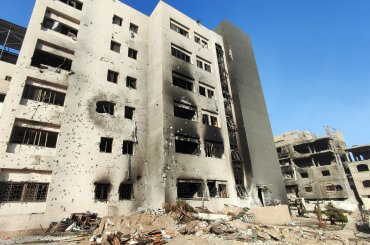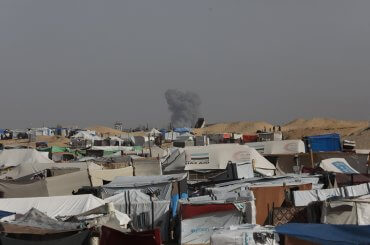Content warning: This article discusses suicide and contains references to suicide, depression, and self-harm.
At 2 a.m. on August 19, 27-year-old Ahmad al-Najjar from Khan Younis ended his life. He wrote a public post on his Facebook page right before, asking forgiveness of his family and friends for what he was about to do. “I have to leave this world,” his post read. “I have spared no effort in trying to recover from my depression during the past eight years, including electroshock therapy last year…but I can’t stand all this pain inside me. I can’t live with it.
“I apologize to my mother, to my sisters, and to the people I love, and to those who love me. Forgive me.”
Shortly after the post went up, people started contacting his family to warn them of what he was about to do. Yet minutes after posting, Ahmad was already dead.
Over the past two decades, suicide cases in Gaza have steadily climbed. The reason for this shouldn’t be surprising to even the casual observer — for most young people in Gaza living under inhumane conditions, their outlook on life is not gray but black, the result of continuous shocks, wars, and two decades of being cut off from the outside world.
Whenever a person takes their life in Gaza, it becomes widespread news. A part of this relates to the social stigma attached to suicide, partly explained by religious and cultural attitudes towards it — for many Muslims, killing oneself is equal to killing another person. In fact, in Gaza, suicide is considered illegal, and Palestinian law criminalizes suicide attempt survivors, dealing with them as if they had attempted murder on another person. The result is that, for many, a suicide in the family is not only a source of tragedy but also of shame. Ahmad’s family and close friends, who appeared with him in several photos on his profile, refused to speak to Mondoweiss regarding the conditions that caused him to take his life.
Suicide survivors speak
Inside his home in al-Shuja’iyyah, east of Gaza, Ibrahim Wadi, 51, is seated on the floor of his living room mattress. Next to him are dozens of medications and anti-depression pills; he has been receiving mental health care for over 20 years.
He recently attempted to take his life.
Ibrahim has been unemployed for over 20 years and receives a monthly aid payment of 800 shekels from the Palestinian Authority because he was injured during the Second Intifada. Yet his income is barely enough to cover the costs of the portion of his medication not covered by governmental insurance.
Last year, he took a gallon of gasoline and went to a cemetery. There, he poured the gasoline over his head and lit himself on fire. By coincidence, a group of passers-by near the graveyard saw him and rushed over to rescue him, taking him to the hospital.
He spent months in intensive care, both for the physical and psychological damage that was done to him. Today, Ibrahim is left with burn marks over his face and body, which he says scared his children at first.
“It’s a hard life, and an ever harder future in Gaza,” he tells Mondoweiss. “I spent my life recovering and taking all kinds of pills that doctors prescribed for me. But I’ve had enough of all this suffering. I wish that I was successful, and that I left this life. I look to my kids every day, and wonder what I can offer them. And I think they can do better without me.”
Ibrahim’s mental health condition has impacted his three teenagers and their mother the most. After his recent suicide attempt, his eldest son didn’t show up to school and ended up missing his last year of high school, all because he could not bear other students whispering and asking questions about his father after his suicide attempt became public knowledge.
Ibrahim’s wife, Nawal, 44, started working at a sewing factory to support their two sons and daughter, given that Ibrahim’s disability income isn’t enough for the family to live on.
“The family has been badly affected by the accident,” Nawal says, referencing Ibrahim’s suicide attempt. “My daughter has negative thoughts about her father burning all of us while we’re sleeping. I admit that sometimes I think of that as well.”
Local debate on suicide in Gaza
Not everyone in Gaza is convinced that suicide rates have risen to the level of becoming a public health crisis. Dr. Jamil Suleiman, the head of the Mental Health department in the Palestinian Ministry of Health in Gaza, has downplayed the scope of the phenomenon.
“The mental health sector in Gaza is good. People receive treatment in six centers across the strip, one center in every province, and two centers in Gaza City, due to its population density,” Suleiman told Mondoweiss. “Palestine is at the bottom of the list of national suicide rates compared to countries that enjoy the best economic conditions.”
Suleiman also denies that the Israeli blockade and the state of the economy has much to do with suicide in Gaza, instead referring it to social issues and family disputes, which he claims account for over 70% of suicide cases in Gaza.
The available data on suicide in Gaza, such as it is, shows a recent clear rise in suicide cases as compared to previous years. Between 2015 and 2018 (in the aftermath of the Israeli war on Gaza in 2014, which killed over 2,000 people), the number of suicide cases doubled from 10 to 20 suicides for every 400-600 attempts. In 2020, Gaza police recorded 17 suicide cases out of 400 attempts. These numbers only reflect cases that have been discovered — many others have been secretly buried for fear of social shame.
Yet even there, Suleiman downplays the significance of these numbers. “The suicide rate in Palestine is meager and is not any cause for concern,” Suleiman emphasizes before adding, “but we should not ignore this number and look deep into the social problems that are connected to it.”
Other practicing psychologists in Gaza have a completely different view. Fadil Ashour, a local psychologist, says that the chronic deprivation faced by his patients is one of the primary causes of the deterioration in their mental health.
“They have no jobs, no [freedom of] movement. They can’t even get married because of the financial crisis in Gaza,” Ashour told Mondoweiss. “Extreme deprivation among these age groups…can bring about its own set of psychological disorders and leave a psychological impact on people.”
Ashour believes that the resort to suicide is one of the adaptation mechanisms that people are forced into as a result of these conditions.
“We see horrific numbers of children who grew up and now have post-traumatic stress disorder,” Ashour explained, emphasizing the effect that the bombing of residential neighborhoods has had on young adults in Gaza throughout the course of Israel’s wars on the coastal enclave. “The death and destruction chase them in their dreams, and they have no way to escape it.”
Chronic poverty also means that many of Ashour’s patients are unable to afford their medications. “Many of my patients are forced to stop their medications, and then I hear that they died by suicide on the news or on social media,” Ashour said. “The number of my patients who have resorted to suicide is dangerously higher now than in previous years.”
“The wills that they post before their death are a final cry of pain. Some of my patients have posted on social media only minutes before their deaths. It’s a cry to their loved ones and relatives,” Ashour said.
When challenged with Ashour’s testimony and recent data showing the rise in suicide cases, Dr. Suleiman maintained his position that the suicide crisis in Gaza is overblown.
“It’s correct that we have seen an increase in cases of suicide in Gaza, but it’s a simple increase that happens from time to time,” he told Mondoweiss.
Suleiman also challenged the claim that exposure to violence is behind this rise. “At many points in time, when the incidence of wars and tightening conditions on people increased in Gaza, suicide rates remained unaffected,” he said.
Suleiman’s account flies in the face of the claims of local psychologists and international and foreign agencies and organizations. OCHA claims that the leading causes of mental health deterioration in Gaza are “recurrent violence, the ongoing blockade, deteriorating living conditions, including increasing poverty, and a sense of hopelessness,” while the Norwegian Refugee Council (NRC) found that “68 percent of schoolchildren in areas close to Israel’s perimeter fence” showed “psychosocial distress.”
Suleiman’s account is partially bolstered by general data from the WHO, which reports that the Middle East has one of the lowest suicide rates in the world — a rate of 6.4 people for every 1000, whereas the international rate is 9. But this data is so broad that it doesn’t tell us much about Gaza, nor the unique conditions to which its people are subjected.
But what becomes readily apparent for any observer is that a significant number of those who have died by suicide or attempted suicide indicate their economic circumstances as one of the causes of their plight. Their experiences and testimonies, anecdotal though they may be, must be centered in any public discussion of suicide.
“Tell me one thing,” Ibrahim Wadi told Mondoweiss. “If I have a good life, work, funds to support my family, and if I have a future, would anything push me to end my life?
“But when you find yourself dead while you’re still breathing and believe that death is better than living this kind of life, ending your life becomes a normal choice.”


